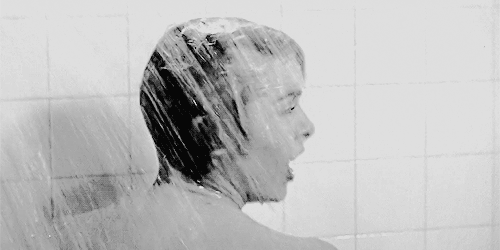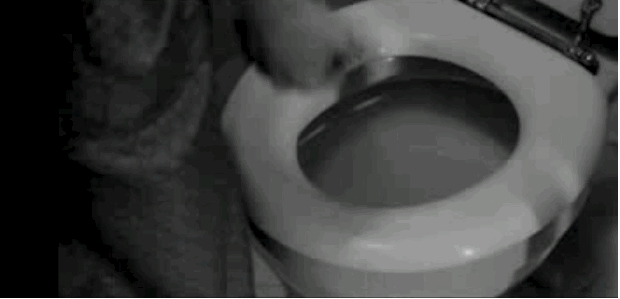Psycho film review
Psycho is another of Hitchcock's highly renown films that helped to shape the direction that both horror films and movies in general moved. The film set a new level of acceptance of both sexual and violent behaviour. It is influential enough for the US library of congress to select it for preservation in the National Film Registry due to it's culturally, historically or aesthetically significant content.
Figure. 1 Shower (1960)
As with others of Hitchcock's films, Pyscho is based on a novel by Robert Bloch. (Fig. 2) The novel itself is based on a real life American murderer called Ed Gein who was prevalent in the 1950s."When Robert Bloch's novel was published in 1959, Hitchcock bought all copies to keep the plot twists under wraps. Similarly, studio execs and theatre owners were given no detail about the film." Gray (2017)
Kermode, M. (2010) Psycho: the best horror film of all time At: https://www.theguardian.com/film/2010/oct/22/psycho-horror-hitchcock (Accessed on 25/01/18)
Figure. 1 Shower (1960)
As with others of Hitchcock's films, Pyscho is based on a novel by Robert Bloch. (Fig. 2) The novel itself is based on a real life American murderer called Ed Gein who was prevalent in the 1950s."When Robert Bloch's novel was published in 1959, Hitchcock bought all copies to keep the plot twists under wraps. Similarly, studio execs and theatre owners were given no detail about the film." Gray (2017)
Figure 2. Psycho cover (1959)
Paramount reluctantly agreed to a small budget for the film without asking any questions. "Hitchcock [...] made Psycho fast and cheap to entertain a mainstream audience, using his regular TV crew and shooting in black-and-white to give the production a verite news-footage feel." Kermode (2010)
Another of Hitchcock's decisions around Psycho completely changed the behaviours of movie goers in general. He banned all audience members from arriving late into the film. This precedent became the normal, both in America and the UK. Previously individuals would simply walk into the film at any time, and even stay for the next showing to catch up on what they had missed.
The key engaging and influential aspects to come from this film were the extreme plot twists and intentional misleading of the audience. Initially the film would appear only to have the sexual shocking element to it. Surprisingly to many modern audiences, the nudity and sexual influences were not the most shocking to contemporary audiences, but rather the shot of a toilet flushing was (fig. 3). This format of establishing one, seemingly key story, only to then be confused and shown another is a trope that continues on into modern horror and thriller films.
Figure 3. Toilet flush (1960)
Psycho is a timeless movie and one that is still much respected. This is often suggested to be due to the use of implied elements rather than directly showing them. For example, at the end of the film, the audience is shown blood going down the drain hole, as well as Janet Leigh's un-moving eye. This reduction of the amount of actual gore shown adds to the suspense of the film and makes more of our emotion focused on the plot twists rather than the horror side of it.
"This remains the most effective slashing in movie history, suggesting that situation and artistry are more important than graphic details." Ebert (1998)
Bibliography
Ebert, R. (1998) Psycho At: https://www.rogerebert.com/reviews/great-movie-psycho-1960 (Accessed on 25/01/18)
Gray, T. (2017) Secrecy surrounding 1960's 'Psycho' Went off without a Hitch At: http://variety.com/2017/film/news/alfred-hitchcock-psycho-secret-1202457671/ (Accessed on 25/01/18)
List of Illustrations
Figure 1. Shower (1960) [Film capture] At: https://dreamgifs5.files.wordpress.com/2016/06/23.gif?w=593 (Accessed on 25/01/18)
Figure 2. Psycho cover (1960) [Book cover] At: https://horrornovelreviews.files.wordpress.com/2012/11/psycho.jpg (Accessed on 25/01/18)
Figure 3. Toilet Flush (1960) [Film capture] At: https://i2.wp.com/bloody-disgusting.com/wp-content/uploads/2015/07/Psycho.gif (Accessed on 25/01/18)






Hello again!
ReplyDeleteFirstly, see my comment on 'Rope' for details on referencing after quotes...
Although you have discussed some very interesting and valid points here, I feel that you could also have talked a little about the use of sound, and the iconic violin screech, as a means of giving the audience the impression of violence, despite there being very little blood etc.
Just one other point; you say, 'For example, at the end of the film, the audience is shown blood going down the drain hole, as well as Janet Leigh's un-moving eye. ' This event actually happens quite early on in the film, not at the end; this is an important point, because the audience is suddenly deprived of their heroine, when they were just starting to identify with her.